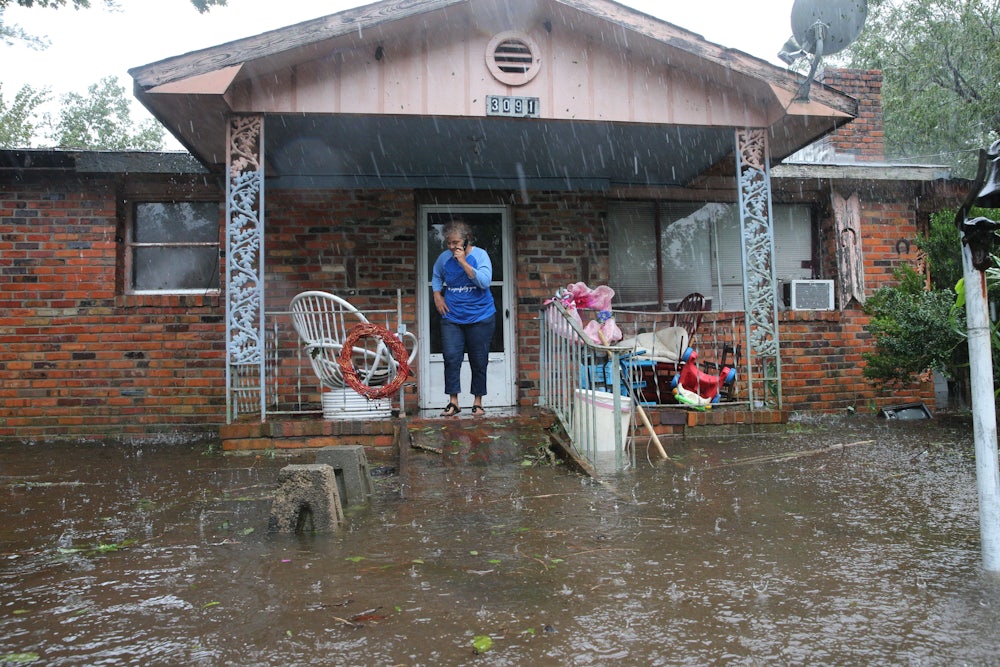If Hurricane Florence were an animal, she’d be a sloth—albeit an unusually dangerous one. The storm became a major hurricane on September 9, prompting potentially apocalyptic but uncertain forecasts. By September 11, more than one million people had been told to evacuate their homes, as Florence was most certainly inching toward the Carolina coastline. The system made landfall in North Carolina as a Category 1 hurricane on Friday, September 14, where it decided to spend the weekend. And though its been downgraded to a tropical depression, Florence continues to rage over the state as of Monday morning.
The four days Florence has spent in North Carolina has helped it break the state record for rainfall during a tropical storm or hurricane, The Washington Post reported on Sunday, citing “a preliminary report of more than 30 inches.” Put another way, meteorologist Ryan Maue told the paper, about six trillion gallons of water has fallen from the sky. That rain and wind has so far left 18 dead and 750,000 without power.
The sloth’s wrath, however, is still far from over—and in some ways it’s just begun. By the time Florence leaves the East Coast later this week, Maue said, the rain total could rise to “18 trillion gallons, enough to cover Texas in four inches of water and fill the Chesapeake Bay.” That means rivers will continue to overflow, delivering sudden, catastrophic flooding to nearby communities. It’s already happening in North Carolina, where there have been more than 900 water rescues so far. Up to six more inches of rain could fall by Tuesday evening, according to CNN.
“This storm has never been more dangerous than it is right now,” the state’s governor, Roy Cooper, said on Sunday. “Many rivers are still rising, and are not expected to crest until later today or tomorrow.”
It’s nearly impossible to get in or out of Wilmington, N.C. right now b/c of rising floodwater. We saw “William”, who’s been stuck in his big rig since this AM. He had food & water but no cell service. He asked us to call his wife. We called her & 911 to give them his location. pic.twitter.com/4psbL9NdU2
— David Begnaud (@DavidBegnaud) September 16, 2018
Drowning is the main risk from these river overflows, as most people who die in hurricanes die due to flooding from storm surge or rainfall. But the extended rainfall is also threatening to make people sick. At least one pit of coal ash—the waste left over from coal burning—has overflowed near the Cape Fear River, according to NBC News, which added, “There are at least two other coal-fired Duke plants in North Carolina that are likely to be affected by the storm.” Coal ash often contains metals like lead, mercury, arsenic, chromium, and selenium, exposure to which can increase the risk of various health problems.
Governor Cooper said on Sunday that the state’s 4,000 hog manure pits—which had overflowed into drinking water systems during previous storms—have not overflowed this time around. “We are closely monitoring hog lagoons, and we haven’t had any reports of issues,” he said. But not everyone was buying the assessment. “I’d like to see some evidence to show that somehow swine farms and lagoons have been magically spared as everything else fell under water,” University of North Carolina environmental sciences professor Mark Sobsey told Bloomberg. “It’s just a little bit hard to believe.”
The flooding will continue. On Monday morning, the National Weather Service said flash flood warnings were still in effect across large portions of North Carolina, South Carolina, and Virginia, and that “heavy and excessive rainfall” could be expected in Pennsylvania, New York, Maryland and southern New England over the next few days. And more slow storms like Florence can be expected to hit the U.S. in the future. “Tropical cyclones, which include hurricanes, have grown more sluggish since the mid-20th century,” the New York Times reported last week, citing research that suggests climate change is playing a role.
